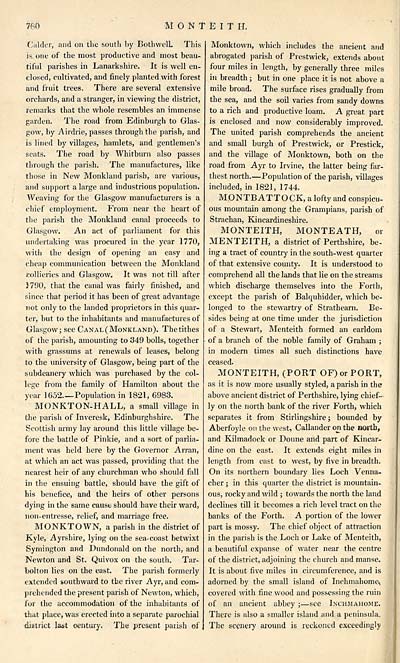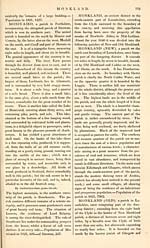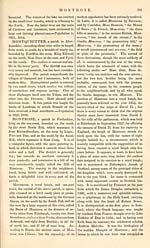Gazetteer of Scotland > Volume 2
(296) Page 780 - MON
Download files
Complete book:
Individual page:
Thumbnail gallery: Grid view | List view

7-80
MONTEITH.
Calder, and on the south by BothvvclL This
is one of the most productive and most beau-
tiful parishes in Lanarkshire. It is well en-
closed, cultivated, and finely planted with forest
and fruit trees. There are several extensive
orchards, and a stranger, in viewing the district,
remarks that the whole resembles an immense
garden. The road from Edinburgh to Glas-
gow, by Airdrie, passes through the parish, and
is lined by villages, hamlets, and gentlemen's
seats. The road by Whitburn also passes
through the parish. The manufactures, like
those in New Monkland parish, are various,
and support a large and industrious population.
Weaving for the Glasgow manufacturers is a
chief employment. From near the heart of
the parish the Monkland canal proceeds to
Glasgow. An act of parliament for this
undertaking was procured in the year 1770,
with the design of opening an easy and
cheap communication between the Monkland
collieries and Glasgow. It was not till after
3790, that the canal was fairly finished, and
since that period it has been of great advantage
not only to the landed proprietors in this quar-
ter, but to the inhabitants and manufactures of
Glasgow; see Canal (Monkland). The tithes
of the parish, amounting to 349 bolls, together
with grassums at renewals of leases, belong
to the university of Glasgow, being part of the
subdeanery which was purchased by the col-
lege from the family of Hamilton about the
year 1652 Population in 1821, 6983.
MONKTON-HALL, a small village in
the parish of Inveresk, Edinburghshire. The
Scottish army lay around this little village be-
fore the battle of Pinkie, and a sort of parlia-
ment was held here by the Governor Arran,
at which an act was passed, providing that the
nearest heir of any churchman who should fall
in the ensuing battle, should have the gift of
his benefice, and the heirs of other persons
dying in the same cause should have their ward,
non-entresse, relief, and marriage free.
MONKTOWN, a parish in the district of
Kyle, Ayrshire, lying on the sea-coast betwixt
Symington and Dundonald on the north, and
Newton and St. Quivox on the south. Tar-
bolton lies on the east. The parish formerly
extended southward to the river Ayr, and com-
prehended the present parish of Newton, which,
for the accommodation of the inhabitants of
that place, was erected into a separate parochial
district last century. The present parish of
Monktown, which includes the ancient and
abrogated parish of Prestwick, extends about
four miles in length, by generally three miles
in breadth ; but in one place it is not above a
mile broad. The surface rises gradually from
the sea, and the soil varies from sandy downs
to a rich and productive loam. A great part
is enclosed and now considerably improved.
The united parish comprehends the ancient
and small burgh of Prestwick, or Prestick,
and the village of Monktown, both on the
road from Ayr to Irvine, the latter being far-
thest north. — Population of the parish, villages
included, in 1821, 1744.
MONTBATTOCK, a lofty and conspicu-
ous mountain among the Grampians, parish of
Strachan, Kincardineshire.
MONTEITH, MONTEATH, or
MENTEITH, a district of Perthshire, be-
ing a tract of country in the south-west quarter
of that extensive county. It is understood to
comprehend all the lands that lie on the streams
which discharge themselves into the Forth,
except the parish of Balquhidder, which be-
longed to the stewartry of Strathearn. Be-
sides being at one time under the jurisdiction
of a Stewart, Menteith formed an earldom
of a branch of the noble family of Graham ;
in modern times all such distinctions have
ceased.
MONTEITH, (PORT OF) or PORT,
as it is now more usually styled, a parish in the
above ancient district of Perthshire, lying chief-
ly on the north bank of the river Forth, which
separates it from Stirlingshire; bounded by
Aberfoyle on the west, Callander on the north,
and Kilmadock or Doune and part of Kincar-
dine on the east. It extends eight miles in
length from east to west, by five in breadth.
On its northern boundary lies Loch Venna-
cher ; in this quarter the district is mountain-
ous, rocky and wild ; towards the north the laud
declines till it becomes a rich level tract on the
banks of the Forth. A portion of the lower
part is mossy. The chief object of attraction
in the parish is the Loch or Lake of Menteith,
a beautiful expanse of water near the centre
of the district, adjoining the church and manse.
It is about five miles in circumference, and is
adorned by the small island of Inchmahome,
covered with fine wood and possessing the ruin
of an ancient abbey ; — see Inchmahome.
There is also a smaller island and a peninsula.
The scenery around is reckoned exceedingly
MONTEITH.
Calder, and on the south by BothvvclL This
is one of the most productive and most beau-
tiful parishes in Lanarkshire. It is well en-
closed, cultivated, and finely planted with forest
and fruit trees. There are several extensive
orchards, and a stranger, in viewing the district,
remarks that the whole resembles an immense
garden. The road from Edinburgh to Glas-
gow, by Airdrie, passes through the parish, and
is lined by villages, hamlets, and gentlemen's
seats. The road by Whitburn also passes
through the parish. The manufactures, like
those in New Monkland parish, are various,
and support a large and industrious population.
Weaving for the Glasgow manufacturers is a
chief employment. From near the heart of
the parish the Monkland canal proceeds to
Glasgow. An act of parliament for this
undertaking was procured in the year 1770,
with the design of opening an easy and
cheap communication between the Monkland
collieries and Glasgow. It was not till after
3790, that the canal was fairly finished, and
since that period it has been of great advantage
not only to the landed proprietors in this quar-
ter, but to the inhabitants and manufactures of
Glasgow; see Canal (Monkland). The tithes
of the parish, amounting to 349 bolls, together
with grassums at renewals of leases, belong
to the university of Glasgow, being part of the
subdeanery which was purchased by the col-
lege from the family of Hamilton about the
year 1652 Population in 1821, 6983.
MONKTON-HALL, a small village in
the parish of Inveresk, Edinburghshire. The
Scottish army lay around this little village be-
fore the battle of Pinkie, and a sort of parlia-
ment was held here by the Governor Arran,
at which an act was passed, providing that the
nearest heir of any churchman who should fall
in the ensuing battle, should have the gift of
his benefice, and the heirs of other persons
dying in the same cause should have their ward,
non-entresse, relief, and marriage free.
MONKTOWN, a parish in the district of
Kyle, Ayrshire, lying on the sea-coast betwixt
Symington and Dundonald on the north, and
Newton and St. Quivox on the south. Tar-
bolton lies on the east. The parish formerly
extended southward to the river Ayr, and com-
prehended the present parish of Newton, which,
for the accommodation of the inhabitants of
that place, was erected into a separate parochial
district last century. The present parish of
Monktown, which includes the ancient and
abrogated parish of Prestwick, extends about
four miles in length, by generally three miles
in breadth ; but in one place it is not above a
mile broad. The surface rises gradually from
the sea, and the soil varies from sandy downs
to a rich and productive loam. A great part
is enclosed and now considerably improved.
The united parish comprehends the ancient
and small burgh of Prestwick, or Prestick,
and the village of Monktown, both on the
road from Ayr to Irvine, the latter being far-
thest north. — Population of the parish, villages
included, in 1821, 1744.
MONTBATTOCK, a lofty and conspicu-
ous mountain among the Grampians, parish of
Strachan, Kincardineshire.
MONTEITH, MONTEATH, or
MENTEITH, a district of Perthshire, be-
ing a tract of country in the south-west quarter
of that extensive county. It is understood to
comprehend all the lands that lie on the streams
which discharge themselves into the Forth,
except the parish of Balquhidder, which be-
longed to the stewartry of Strathearn. Be-
sides being at one time under the jurisdiction
of a Stewart, Menteith formed an earldom
of a branch of the noble family of Graham ;
in modern times all such distinctions have
ceased.
MONTEITH, (PORT OF) or PORT,
as it is now more usually styled, a parish in the
above ancient district of Perthshire, lying chief-
ly on the north bank of the river Forth, which
separates it from Stirlingshire; bounded by
Aberfoyle on the west, Callander on the north,
and Kilmadock or Doune and part of Kincar-
dine on the east. It extends eight miles in
length from east to west, by five in breadth.
On its northern boundary lies Loch Venna-
cher ; in this quarter the district is mountain-
ous, rocky and wild ; towards the north the laud
declines till it becomes a rich level tract on the
banks of the Forth. A portion of the lower
part is mossy. The chief object of attraction
in the parish is the Loch or Lake of Menteith,
a beautiful expanse of water near the centre
of the district, adjoining the church and manse.
It is about five miles in circumference, and is
adorned by the small island of Inchmahome,
covered with fine wood and possessing the ruin
of an ancient abbey ; — see Inchmahome.
There is also a smaller island and a peninsula.
The scenery around is reckoned exceedingly
Set display mode to: Large image | Transcription
Images and transcriptions on this page, including medium image downloads, may be used under the Creative Commons Attribution 4.0 International Licence unless otherwise stated. ![]()
| Gazetteers of Scotland, 1803-1901 > Gazetteer of Scotland > Volume 2 > (296) Page 780 - MON |
|---|
| Permanent URL | https://digital.nls.uk/97434374 |
|---|
| Description | Volume II: Glenbanchor to Zetland. |
|---|---|
| Attribution and copyright: |
|
| Description | By Robert Chambers and William Chambers. Glasgow: Blackie & Son, 1838. 2 volumes. |
|---|---|
| Shelfmark | NF.1461.g.7 |
| Additional NLS resources: | |

